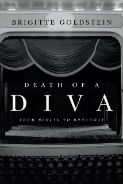
 |
Grand in its scope and intricate in its design, this ambitious story attempts to bridge time and space—and accomplishes both quite nicely. Likewise, the author seamlessly melds the murder mystery and historical fiction genres, although the story reads much more like intertwined biographies of fictional characters and real-life individuals.
Many historical novels set aside an excessive number of introductory pages to setting the scene for the reader, slowly drawing the reader into a gradually unfolding plot. Such is not the case with Goldstein's work. From the very start, the book abruptly uproots the reader, and transplants him to another time and place in which the narrator has been straight away taken in for questioning in the brutal murder of screen siren Stella Berger.
The narrator is Misia Safran, a Jewish refugee who escaped the Nazi regime along with her showbiz parents. After enduring an exhaustive interrogation at the start of the novel, Misia takes a backseat in the drama, serving as a facilitator to move the story along rather than playing a central role. When the police inspectors seize upon a new suspect, Viktor Erdos, Misia serves as a de facto police interpreter. Despite most of the characters believing in Erdos' innocence, the press and public are hungry for a guilty verdict to close the case on the murder of their beloved Stella. And so, Erdos is essentially hung out to dry, which prompts Misia to step into a more central role, playing an amateur detective to ferret out the true killer(s).
Along the way, Misia suffers personal setbacks. She discovers multiple betrayals and eventually learns that she is a pawn in a much wider plot that involves disturbing acts of anti-Semitism. These revelations serve to further her character development. At the start, Misia appears to be a naïve young girl, yet with the bravery to be on her own seeking her own fortune amidst a hostile climate of anti-Semitism. Toward the end as she takes an active role in the investigation, she becomes much more assertive. Although many of the characters' natures appear relatively static—only delayed in the true revelation of them—Misia's character is wonderfully developed over the course of the story. Since the reader never gets to know the late Stella in present-time, her true nature is as dubious as the list of suspected killers. The Stella the reader becomes acquainted with is only seen through the eyes of those who used to know her, and these various accounts of Stella are as diverse and as contradictory as the personas who tell them.
The character development isn't the only aspect of the story that the author executes well. Although the language is highly descriptive and there are frequent asides, sometimes to the point of distracting from the story, the author masterfully directs the reader's attention back to the plot again. She carefully interweaves multiple accounts of the past and constructs an apt picture of the atmosphere during the Weimar Republic—from the smoke-filled coffeehouses and clubs to the many famous names who came into their own during that period.
To the very last pages, the reader will be kept grasping at straws in an attempt to discern the true murderer and motive. Much more than simply a murder mystery, this book is above all a coming of age story and a cautionary tale warning of the dangers of the clash of cultures absent unbiased acceptance. It also warns of the risk one takes in presuming to truly know another's genuine self. However, in the final few pages, a half-baked attempt at redemption and a deathbed confession are sufficient to finally close the chapter on this microcosm of an American version of the Weimar Republic.
RECOMMENDED by the US Review